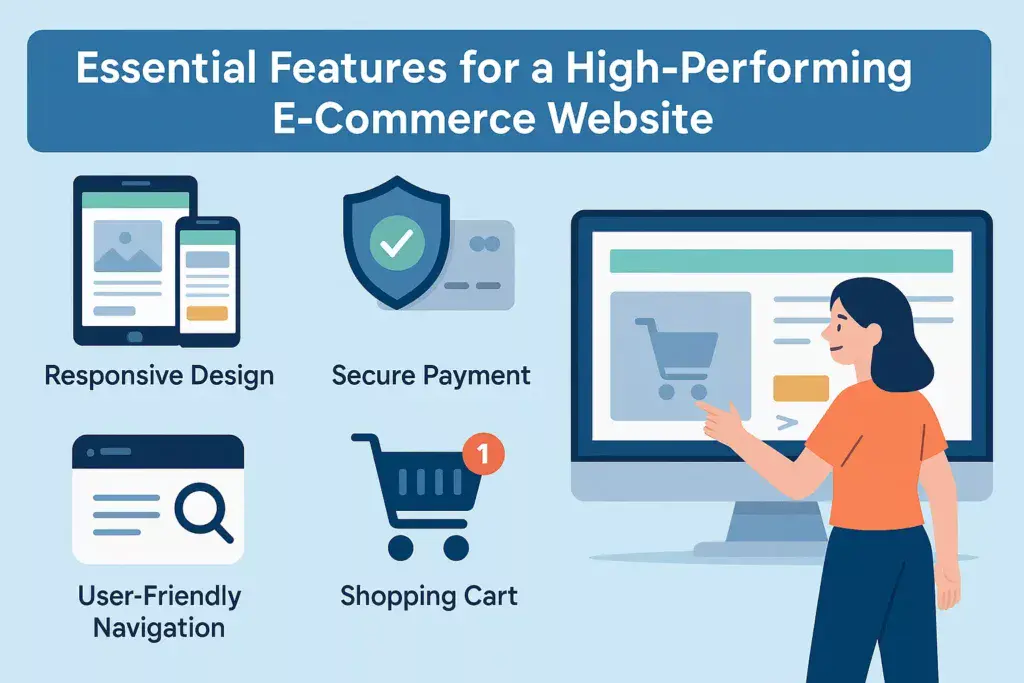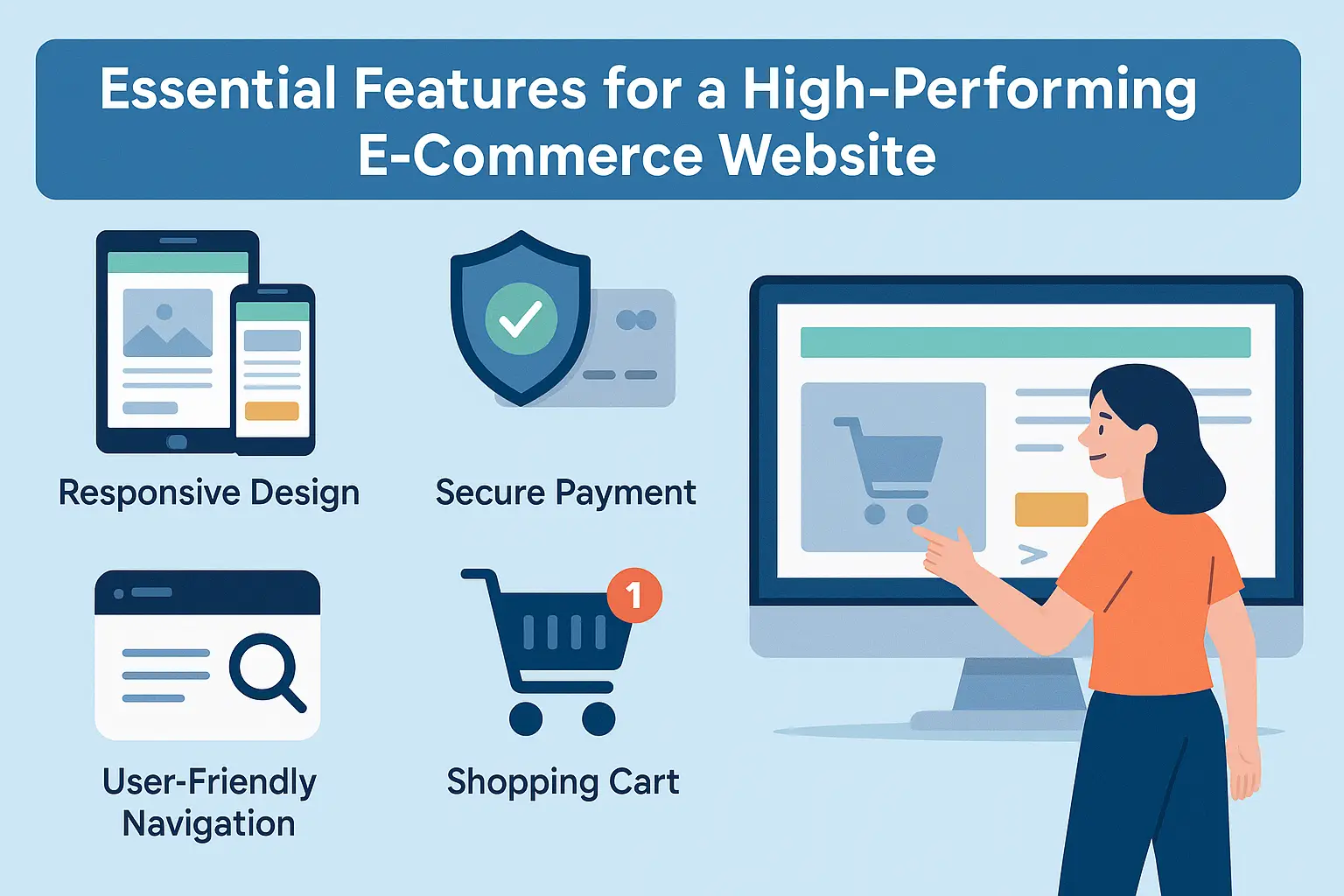
E-commerce website features are the backbone of a high-performing online store. With millions of shops competing for attention, the right features shape first impressions, strengthen brand credibility, and nudge visitors toward checkout. When these core website features work together, they elevate UX, conversions, and long-term loyalty.
A successful store is more than a catalog—it’s an experience guided by intentional e-commerce website features like intuitive navigation, responsive design, and secure payments. This guide explains how each component supports both business goals and customer needs from landing page to checkout.
I. Introduction to E-commerce Website Design
In today’s digital age, the significance of a well-designed e-commerce site cannot be overstated. With millions of online stores competing for attention, the first impression often hinges on the website’s design. A thoughtfully crafted e-commerce platform not only showcases products but also reflects the brand’s identity, establishes credibility, and attracts potential customers.
A successful e-commerce website is more than just an online storefront; it serves as a virtual experience that guides users through their shopping journey. This article will explore essential features that contribute to effective e-commerce website design, ensuring that it meets the needs of both the business and its customers.
Key features such as user-friendly navigation, responsive design, and secure payment options play a crucial role in enhancing user experience. These elements are not merely aesthetic; they directly impact conversion rates, customer satisfaction, and ultimately, sales. An intuitive and engaging website can lead to increased customer loyalty and repeat business, making it a vital component of any successful e-commerce strategy.
As we delve into the fundamental aspects of e-commerce website design, it is important to consider how these features work together to create a seamless shopping experience. From the initial landing page to the final checkout process, every element contributes to the overall effectiveness of an online store.
II. User-Friendly Navigation
A well-structured navigation system is a cornerstone of effective e-commerce website design. User-friendly navigation not only enhances the overall experience but also plays a significant role in guiding visitors towards making purchases. When users can easily find what they are looking for, they are more likely to stay on the site longer and convert their searches into sales. Below, we explore the essential components of user-friendly navigation in e-commerce.
A. Clear Menu Structure and Categories
The first step in creating an intuitive navigation experience is establishing a clear and organized menu structure. Categories should be logically arranged and reflect the hierarchy of products offered. For instance, if an online store sells clothing, the main menu might include categories such as Men, Women, Kids, and Accessories. Each of these categories can then expand into subcategories, such as Tops, Bottoms, and Outerwear. This hierarchical approach helps users quickly identify where to find specific items, reducing frustration and enhancing their shopping experience.
Additionally, descriptive labels for categories are essential. Users should be able to understand the content of a category at a glance. Vague or overly creative labels can lead to confusion, prompting users to leave the site in search of clearer options elsewhere. By employing straightforward and descriptive terminology, e-commerce sites can significantly improve the clarity of their navigation.
B. Search Functionality and Filters
In conjunction with a well-organized menu, robust search functionality is crucial for user-friendly navigation. Many shoppers arrive at e-commerce sites with a specific product in mind, and effective search tools empower them to find those items quickly. A search bar that is prominently placed on the homepage can facilitate this process.
Moreover, implementing filters can further enhance the search experience. Filters allow users to narrow down search results based on various criteria, such as price range, size, color, and brand. By providing these options, e-commerce sites can cater to individual preferences, making it easier for users to discover products that meet their specific needs. This tailored experience not only improves user satisfaction but can also lead to increased sales.
C. Breadcrumbs for Easy Backtracking
Another important feature of user-friendly navigation is the use of breadcrumbs. Breadcrumbs are navigational aids that show users their current location within the site’s hierarchy and provide an easy way to backtrack to previous pages. For example, if a user is viewing a specific product under the “Men’s Shoes” category, the breadcrumb trail might appear as “Home > Men > Shoes > [Product Name].”
This feature serves two primary purposes: it enhances the user experience by allowing easy navigation back to previous pages without having to use the back button, and it helps users understand their position within the site’s structure. Breadcrumbs can also improve SEO by providing additional context for search engines about the site’s layout and content.
In summary, user-friendly navigation is essential for a successful e-commerce website. By implementing a clear menu structure, effective search functionality with filters, and breadcrumbs for easy backtracking, businesses can create a seamless shopping experience that encourages users to explore and ultimately make purchases. As we move forward in our discussion of key features, we will explore the importance of responsive and mobile-friendly design in enhancing user experience further.
III. Responsive and Mobile-Friendly Design
In an era where mobile devices dominate internet usage, ensuring that an e-commerce website is responsive and mobile-friendly is not just a luxury but a necessity. With a significant portion of consumers shopping on their smartphones and tablets, a seamless mobile experience can directly influence sales and customer satisfaction.
A. Importance of Mobile Optimization
Mobile optimization refers to the process of ensuring that a website functions efficiently on mobile devices. Statistics show that nearly half of all online shopping is conducted via mobile, making it imperative for e-commerce sites to cater to this audience. A mobile-optimized site enhances usability, allowing users to browse products, read descriptions, and complete purchases with ease, all from their handheld devices. If a website is not mobile-friendly, potential customers may quickly abandon their shopping carts in favor of competitors who offer a better mobile experience.
B. Responsive Layouts for Various Devices
Responsive design is the approach that allows a website to adapt to the screen size and resolution of any device being used. This means that whether a user accesses the site from a desktop, tablet, or smartphone, the layout will automatically adjust to provide an optimal viewing experience. Key elements of a responsive design include fluid grids, flexible images, and CSS media queries. By implementing these techniques, e-commerce websites can maintain visual consistency and functionality across all devices, ensuring that users have a pleasant shopping experience regardless of how they access the site.
C. Touch-Friendly Interfaces
Touch-friendly interfaces are crucial for mobile users, as they rely on tapping and swiping rather than clicking with a mouse. Designing buttons and links that are large enough to easily interact with, as well as ensuring that touch targets are well spaced, can significantly improve usability. Additionally, incorporating gestures, such as pinch-to-zoom for product images or swipe navigation for carousels, can enhance user engagement. A well-designed touch interface not only makes navigation intuitive but also reduces frustration, encouraging users to spend more time on the site and ultimately increasing the likelihood of conversions.
In conclusion, responsive and mobile-friendly design is essential for any successful e-commerce website. By prioritizing mobile optimization, utilizing responsive layouts, and creating touch-friendly interfaces, businesses can provide an exceptional user experience that meets the needs of today’s consumers. This not only enhances customer satisfaction but also boosts sales and fosters long-term loyalty.
IV. Secure Payment Options
In today’s digital landscape, ensuring that customers can complete their transactions safely is paramount for any e-commerce website. The presence of secure payment options not only protects sensitive customer information but also builds trust and confidence in your brand, leading to higher conversion rates.
A. Variety of Payment Methods
Offering a diverse range of payment methods is crucial in catering to the preferences of your customer base. While credit and debit cards remain the most common forms of online payment, integrating options such as digital wallets (e.g., PayPal, Apple Pay, Google Pay), bank transfers, and even cryptocurrency can enhance the shopping experience. By providing multiple payment choices, you accommodate different customer needs and increase the likelihood of completing a sale. This flexibility can be especially beneficial in a global market where payment preferences can vary significantly from one region to another.
B. SSL Certification for Security
To safeguard customer data during transactions, having an SSL (Secure Sockets Layer) certificate is essential. This technology encrypts the information exchanged between the user’s browser and your server, ensuring that sensitive data such as credit card details and personal information remain private and secure from potential cyber threats. Displaying security indicators, such as the padlock icon in the browser address bar, reassures customers that their information is protected, instilling a sense of security as they navigate your site. Furthermore, search engines like Google favor secure websites, which can positively impact your site’s visibility and ranking.
C. User Trust and Confidence in Transactions
Building user trust is a critical component of successful e-commerce. Customers are more likely to complete a purchase if they feel secure about the payment process. Implementing features such as clear return and refund policies, displaying recognized security badges, and providing customer support options can significantly enhance trust. Additionally, sharing testimonials and reviews that highlight positive customer experiences can further reinforce confidence in your website. When users feel assured about the safety of their transactions, they are more inclined to engage with your brand, leading to repeat purchases and long-term loyalty.
In summary, secure payment options are not just a technical necessity; they are a fundamental aspect of user experience that can drive sales and foster customer loyalty. By offering a variety of payment methods, ensuring robust security through SSL certification, and actively working to build user trust, e-commerce sites can create a safe and enjoyable shopping environment for their customers.
V. Conclusion
Creating a successful e-commerce website requires a careful blend of key features that enhance user experience and drive sales. We have explored the importance of user-friendly navigation, which ensures that customers can easily find what they are looking for without frustration. Responsive and mobile-friendly design has become a non-negotiable aspect of modern e-commerce, catering to the growing number of consumers who shop on their mobile devices. Additionally, providing secure payment options is crucial for building user trust and confidence, ultimately leading to increased transaction success.
As we look to the future, e-commerce design will continue to evolve, embracing emerging technologies such as augmented reality, voice search, and personalized shopping experiences. These innovations promise to further enhance user engagement and satisfaction.
In summary, a user-centric approach to e-commerce website design not only improves the shopping experience but also has a significant impact on sales and customer loyalty. By prioritizing these key features, businesses can create compelling online stores that stand out in an increasingly competitive marketplace.



